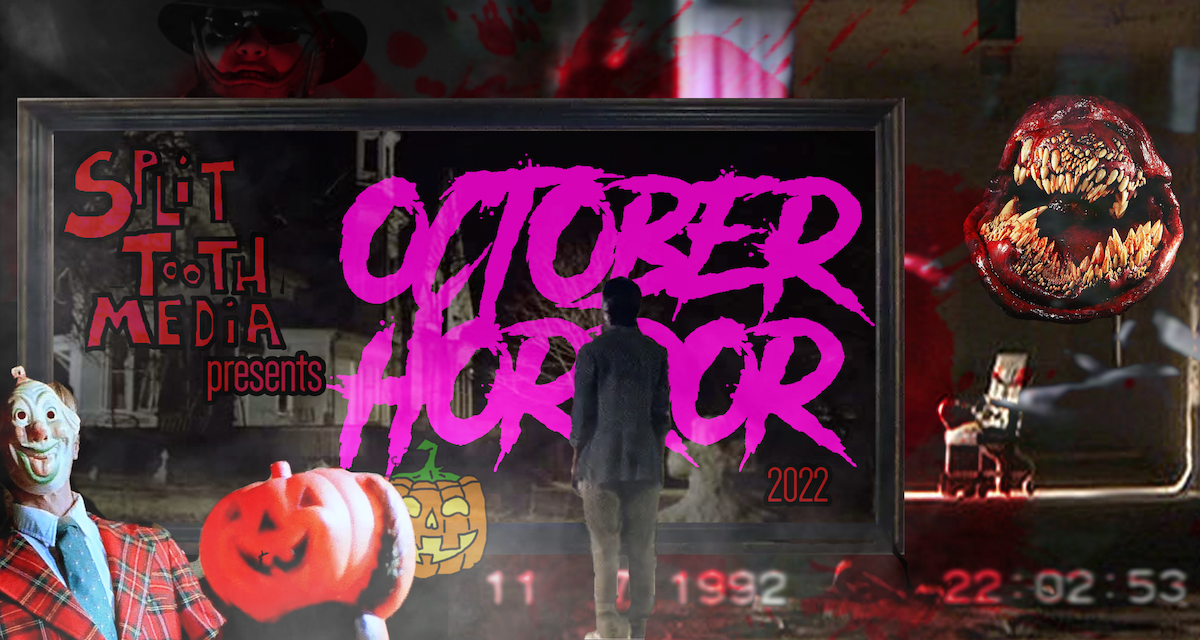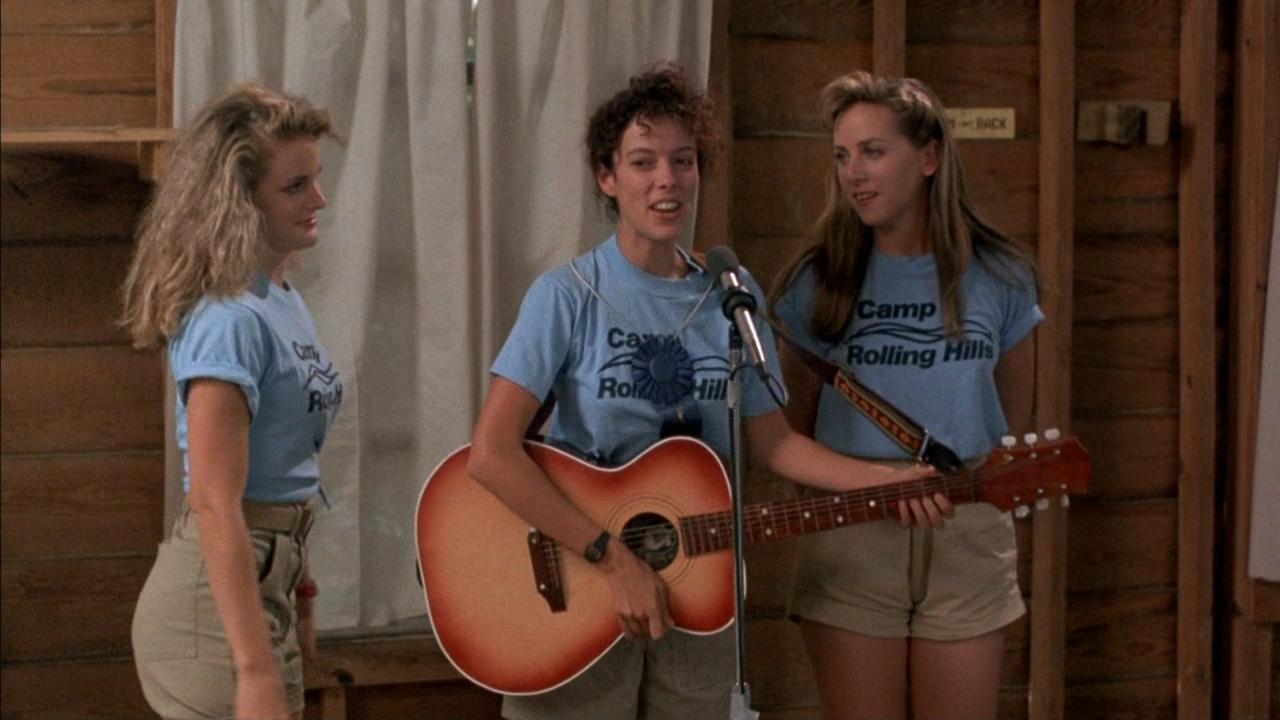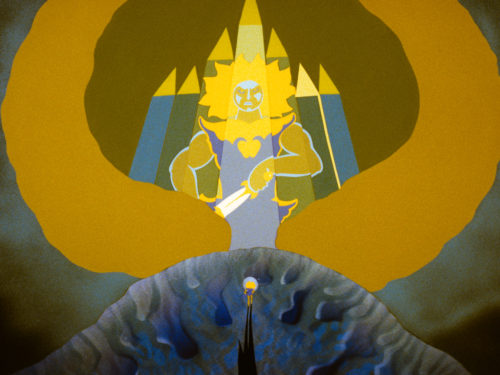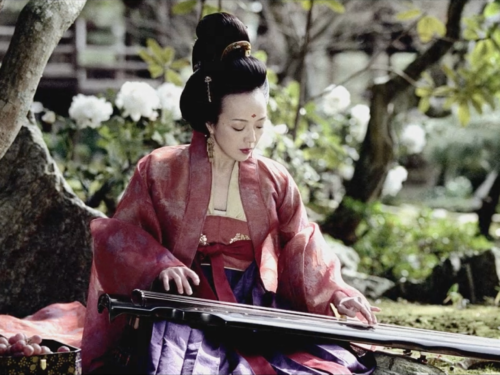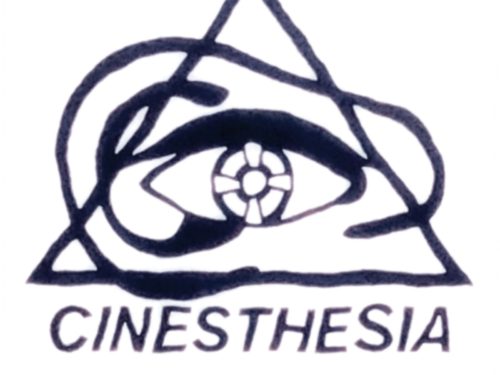With its complicated vision of identity and alienation, the original Sleepaway Camp is one of the most notorious slashers of the 1980s. Its sequels transform Angela “Angel of Death” Baker into a comedic and monstrous villain
Robert Hiltzik’s cult classic Sleepaway Camp (1983) ends with the shocking revelation that the meek Angela Baker (Felissa Rose) is responsible for a series of murders at Camp Arawak. More shockingly, we learn that Angela is “actually” Peter Baker, the brother we were led to believe died in a boating accident years prior. Having been traumatized by witnessing the death of his father and sister in the accident, Peter is taken in by his Aunt Martha (Desiree Gould), who makes him live as a girl with the new name, meaning “angel.” This name takes on new meaning in the franchise’s sequels — Unhappy Campers (1988) and Teenage Wasteland (1989) — as Angela’s murder spree turns her into a campfire story legend known as the “Angel of Death.”
The “Angel of Death” moniker feels out of place for the Angela Baker of the first film, though it makes more sense by the end of the second. As I have previously written, Hiltzik’s original film is quite thoughtful and even sympathetic to Angela’s position as a psychologically destroyed young person who through circumstance is reduced to her monstrosity. The final freeze frame asks us to look past the image of terror that she represents and to see the glimmer of humanity contained within. There are moments in Unhappy Campers and Teenage Wasteland that hint at Angela’s humanity. This is particularly true in Unhappy Campers, where she forms a surprising friendship with one of the female campers; in another moment Angela tries to sleep and is tormented by her horrific thoughts. But, on the whole, neither Unhappy Campers nor Teenage Wasteland are sympathetic to Angela’s situation or her psychological makeup.
Given the popularity of Friday the 13th (1980), A Nightmare on Elm Street (1984) and their respective franchises during the 1980s, these sequels make a clear effort to transform the character of Angela Baker from a subject with the potential for psychological complexity, and even sympathy, into a more generic villain within the tradition of the slasher genre. Naming her the “Angel of Death” is symptomatic of how the sequels attempt to raise the stakes of the franchise by making Angela into an object of horror. Whereas the first accomplishes this by considering the abuse that Angela suffered at the hands of her aunt, Unhappy Campers and Teenage Wasteland are concerned with her as a monster who lets audiences experience the perverse pleasure of seeing teen campers brutally tortured and murdered. Angela becomes something of a vacant character who represents the franchise’s answer to the likes of Freddy Krueger and Jason Voorhees. Yet despite their lack of interest in Angela as a realized character, Unhappy Campers and Teenage Wasteland are perfectly satisfying films in their own right.
Michael A. Simpson’s Unhappy Campers carries the weight of moving Sleepaway Camp into new territory. In the beginning of the film, the teens huddled around the fire at Camp Rolling Hills tell of what happened to Angela after the events of Arawak: She was arrested, institutionalized, and she received sex change surgery. As Sean (Tony Higgins), the son of one of the cops who arrested Angela, exclaims, taxpayer money went toward the surgery to truly change “Peter” into “Angela.” As the campers tell the myth of Angela (and first give voice to the “Angel of Death” nickname), we see a shadowy figure standing in the background. We know to expect that this is Angela, but when she steps out of the shadows we can see this is not the Angela we remember. In the sequels she is played by Pamela Springsteen (yes, she has a brother named Bruce). The visual difference between Springsteen and Rose is seemingly explained away by the surgery, but Springsteen also brings an entirely different interpretation to the role. Whereas Rose played Angela as a painfully shy girl, Springsteen portrays Angela as outgoing and obnoxiously enthusiastic.
Related: The Darwinian Slasher: Backcountry (2014) by Oliver O’Sullivan
With the exception of some references to the original film, one might mistake Unhappy Campers for a cheap knockoff. Even so, it must be said that Springsteen does a commendable job of picking up the mantle. Indeed, Unhappy Campers is to some degree about the self-conscious performance of Angela’s identity. That is, Angela must masquerade as someone else — or rather, as “Angela Johnson” — if she is going to get close enough to campers to kill again. A play on the character’s trans identity, the new name is a kind of comment on the absurdity of the character. That is, the nickname is so obvious that it is hard to believe that even the characters in the world of the franchise would not piece things together, considering that the opening of Unhappy Campers tells us that Angela’s story and modus operandi are well known. This becomes even harder to accept when considering how much of a nuisance Angela is to the other campers because she always ruins whatever good times they are having. But this is also what makes Unhappy Campers so interesting: It is precisely due to Angela being such an over-the-top figure that it is actually plausible that characters would want a kind of psychic distance from her and would overlook some obvious indicators that the Angela Johnson who they know is the same Angela Baker who terrorized a nearby camp not long ago. In other words, it is precisely because Springsteen portrays her Angela as the opposite of the withdrawn character that Rose embodied that she can truly be “Angela” — that is, in the view of Unhappy Campers, the monstrous killer rather than the traumatized girl.
In Unhappy Campers, Angela has somehow landed a job as a counselor at Camp Rolling Hills and she presents herself to the teens as serious about them having a wholesome experience. Unlike the laidback head counselor T.C. (Brian Patrick Clarke), Angela enforces the rules of decorum and seeks to prevent any of the campers from having sex, drinking, or doing drugs: Those who commit such offenses receive their comeuppance. The patriarch of the camp, Uncle John (Walter Gotell) takes a liking to Angela, but he is mostly an absent figure in the film’s events, unlike the camp owner of the previous film, Mel (Mike Kellin). The rest of Rolling Hills is filled out by familiar types: There is good girl Molly (Renée Estevez) and her antithesis, the sexpot Ally (Valerie Hartman); stoner sisters Brooke (Carol Chambers) and Jodi (Amy Fields); the horny doof Rob (Terry Hobbs) and youngsters Charlie (Justin Nowell) and Emilio (Jason Ehrlich) who scour the camp taking inappropriate photos of women (including, incidentally, Angela). Divisions soon take shape among the campers, with Molly and Sean becoming something of an item. Molly takes Angela in as a genuine confidant to talk her through the emerging relationship. Ally and Rob have their own fling, with one amusing scene in which Rob seems to lose his virginity to the indifferent, experienced young woman before Angela exacts her punishment.

Unlike Sleepaway Camp, Unhappy Campers maintains a comedic, self-aware attitude towards Angela’s actions. It is no accident that the campers, including those not listed above, share names with the members of the Brat Pack — Molly is even played by the sister of Emilio Estevez and Charlie Sheen. In this light, Unhappy Campers is a knowing and playful attack on 1980s pop culture. In one scene, two campers, Anthony (Benji Wilhoite) and Judd (Walter Franks III) conspire to scare Angela by dressing up as Jason Voorhees and Freddy Krueger; Angela gets back at them by donning a Leatherface mask and wielding a chainsaw. The spectacle of horrors directed at the icons of 1980s culture is both gruesome and fun, but it also leaves something to be desired. One gets the impression that the film’s self-aware tendencies are a compensatory device meant to prop up the franchise. The mystery around Angela is obviously exhausted by the first film with the revelation that she is both the killer and a biological male. There are, in effect, no more surprises to learn about her. We can hardly see her as more than a figure committed to the almost apocalyptic destruction of cheesy 1980s entertainment. In this sense, she’s not so much a character but the embodiment of a feeling — an awareness that the Brat Pack, that the cultural edifice of the 1980s is just a bit too cute to go on for much longer. Of course, this awareness does not absolve Unhappy Campers from being a little bit too cute itself, either.
Despite its commendable features, one is left with the impression that after the first Sleepaway Camp the franchise simply didn’t have much else to say about Angela; hence, she is changed from a character into a metaphorical statement on the rejection of 1980s culture. But to its credit, Simpson’s Teenage Wasteland attempts to broach something new. In this film, Angela returns as a camper. In fact, the film begins with Angela murdering a girl on the day she leaves for camp, impersonating her, and returning to the same camp from the previous film — renamed “New Horizons” by its new owners, Lilly (Sandra Dorsey) and Herman (Michael J. Pollard). The wife and husband team, though it does seem to be more of Lilly’s idea, has devised a clever way to rehabilitate the camp’s image: A handful of well-to-do and working class teens are brought to the camp from around the country in order to promote “sharing” and a sense of understanding that can cross socio-economic and racial barriers. Angela pretends to be the downtrodden Maria, but this group is also made up of Arab (Jill Terashita), a diffident young Asian woman; Tony (Mark Oliver), the good-natured gang member from East L.A.; and Riff (Daryl Wilcher), an African American teen who threatens the other campers with a knife, gun, and the constant play of his boombox. On the more affluent side are Bobby (Haynes Brooke), a tall midwesterner with political aspirations; Cindy (Kim Wall), a Georgia native who makes no effort to conceal her racism, and Marcia (Tracy Griffith), a girl-next-door who takes an immediate interest in Tony.
Insofar as they are not stand-ins for 1980s stars, there is a bit more weight to these campers. They are stock characters who fill out a familiar narrative ploy — essentially, economically comfortable white teens and more precious non-white teens struggle to get along. The dynamic plays out as one might expect: The wealthier teens are either outright racist to those of color or they clearly don’t know how to interact with them; conversely, the economically disenfranchised teens do not have any interest in socializing with people who have known no hardship in their lives, and never will. In its attentiveness to the social tensions on both sides, the film is clearly aware of the farcical nature of Camp New Horizons and the media stunt that Lilly and Herman are trying to pull off: The gap between the rich and the poor cannot be solved by “understanding” or “sharing” — even if characters from different backgrounds could see things from the other point of view, the only thing that can materially change their lives would be a redistribution of wealth that put the teens on an even playing field. From the start, then, New Horizons offers something impossible — at the end of the day, it does not matter what perspectives the kids learn or don’t, because both groups of campers are just going to return to their economic position, and the rich kids are going to be able to do whatever they want anyway. This is conveyed very well at the end of the film: Marcia and Tony have become an item, and through their connection to each other have survived Angela’s attacks. Tony begins to talk about moving to Ohio to be with Marcia. That’s when she tells him that she has a boyfriend back home — but Tony can still “visit” her. In the end, there is no reconciliation between the upper and lower classes or miscegenation between white American women and Mexican American men. Everyone returns to their starting points. For Marcia, this likely means continuing the path toward an upper-middle-class life; for Tony, he will get out of his gang if he is lucky, but little else seems to be on the horizon for him.

Furthermore, it is not as if Lilly or Herman have organized this camp to create class traitors among the rich. They put so little effort into building even basic social cohesion among the campers that the owners might as well not be at the camp at all. Lilly, Herman, and Barney (Cliff Brand) — the cop who arrested Angela at the end of the first film, and whose son, Sean, was murdered by Angela in Unhappy Campers — are assigned groups of teens to take into the woods for a bonding exercise designed for them to overcome their social differences. Barney is the only adult who cares about the kids, and he tells them he wants to make up for what he lost with the murder of his son. Herman, on the other hand, is concerned only with sleeping with one of the girls, though Angela cuts this short. Lilly could not be any less concerned with the campers if she tried: she cooks a steak for herself while making the teens catch and cook their own fish; they have to fix her coffee and she cannot be bothered to look up from her magazine to talk with them. If there were any suspicions that Lilly and Herman were disingenuous about their concern for mending social wounds in America, those are only affirmed as the film goes on, and it leaves the viewer genuinely wanting Angela to exact punishment over them.
It’s not as if Herman and Lilly are Angela’s sole victims, nor are they the only ones who may deserve their fate. After all, Cindy’s racism and Riff’s constant threats to other campers make them deplorable figures. In a sense, there is something to appreciate about Angela’s murderous rampage in Teenage Wasteland. People like Herman and Lilly deserve to be punished for exploiting this social issue when they are simply concerned with benefiting themselves; However, it is also true that such exploitation is de rigueur in America. The facade of solving economic problems with social solutions (e.g., championing greater racial diversity in companies or on film and television screens without doing anything to enhance the economic position of non-white people in the country) is so common because it makes people feel seen and gives the illusion that something is being done. This is precisely what makes Teenage Wasteland so compelling, because it implies that everyone would be better off if they had not taken part in this stunt. At the end of the day, they are sacrificed at the altar of liberal do-goodery. They were, in other words, killed pointlessly because no real good was going to come of Camp New Horizons anyway. Within the exaggerated world of the film, Angela’s actions are, arguably, admirable insofar as they destroy the entire edifice. As for her victims, the cruel privileged campers will receive a kind of cosmic punishment that they otherwise would never meet; those unfortunate poor and working class souls are freed from the desperation from which there is no other escape. There is no utopia and nothing is permanent in the wasteland.
Throughout the course of the series, Angela changes from a nearly silent and unknowable child, to an agent of self-conscious mischief, to something like an avenging angel. Angela does not become a more textured or nuanced character as the films continue. That is, of course, not necessary for the films to provide everything they need in terms of the gore, excitement, and humor that comes from seeing Angela at work. But while Angela feels less human in Unhappy Campers and Teenage Wasteland, she also seems easier to understand and easier to identify with. Perhaps this is because she seems to be acting on behalf of her audience, whereas in the original she is only acting for herself and her cousin. Perhaps, this is what the transfiguration of an angel looks like.
Stream Sleepaway Camp II: Unhappy Campers and Sleepaway Camp III: Teenage Wasteland on Amazon Prime
Purchase Sleepaway Camp II and Sleepaway Camp III from Amazon
Stay up to date with all things Split Tooth Media and follow Frankie on Twitter
(Split Tooth may earn a commission from purchases made through affiliate links on our site.)
Find the complete October Horror 2022 series here:
